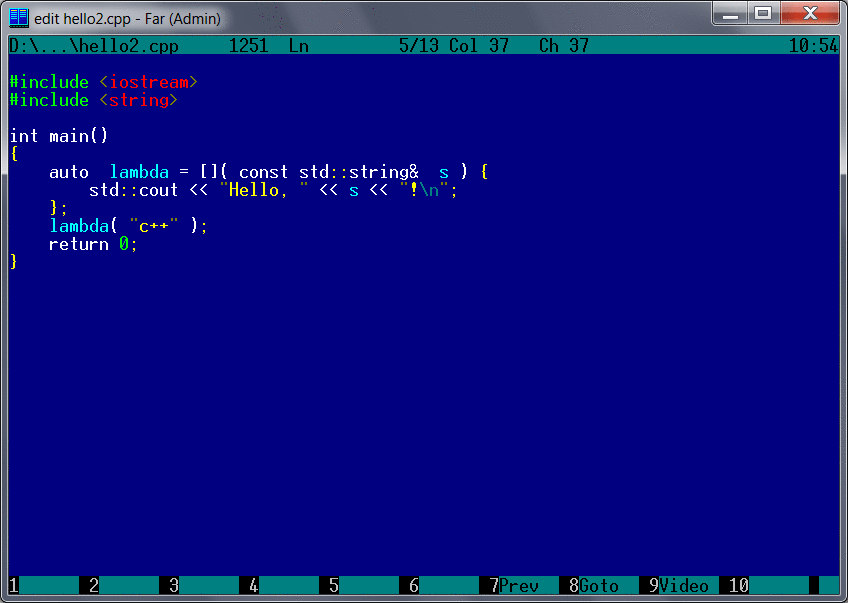

Monitoring Performance"Ĭollapse section "VI. Dumping Protected Process Memory with GDBĮxpand section "VI. Inspecting Application Crash States with Core DumpsĢ1.5. Recording Application Crashes with Core DumpsĢ1.3. Debugging a Crashed Application"Ĭollapse section "21. Using GDB to Intercept the Handling of Signals by ApplicationsĮxpand section "21. Using GDB to Intercept Application System CallsĢ0.3.6. Monitoring the Application’s System Calls with SystemTapĢ0.3.5. Monitoring the Application’s Library Function Calls with ltraceĢ0.3.4. Monitoring an Application’s System Calls with straceĢ0.3.3. Useful Tools for Recording Application InteractionsĢ0.3.2. Recording Application Interactions"Ģ0.3.1. Recording Application Interactions"Ĭollapse section "20.3. Debugging Forking or Threaded Programs with GDBĮxpand section "20.3. Using GDB Watchpoints to Stop Execution on Data Access and ChangesĢ0.2.7.
#How to use eclipse to compile c programs in redhat code
Using GDB Breakpoints to Stop Execution at Defined Code LocationsĢ0.2.6. Showing Program Internal Values with GDBĢ0.2.5. Stepping through Program Code with GDBĢ0.2.4. Inspecting the Application’s Internal State with GDB"Ģ0.2.3. Inspecting the Application’s Internal State with GDB"Ĭollapse section "20.2. Inspecting the Application’s Internal State with GDBĮxpand section "20.2. Getting debuginfo Packages for an Application or Library ManuallyĢ0.2. Getting debuginfo Packages for an Application or Library using GDBĢ0.1.5. Enabling Debugging of C and C++ Applications with GCCĢ0.1.4. Enabling Debugging with Debugging Information"Ģ0.1.2. Enabling Debugging with Debugging Information"Ĭollapse section "20.1. Enabling Debugging with Debugging InformationĮxpand section "20.1. Debugging a Running Application"Ĭollapse section "20. Debugging Applications"Įxpand section "20. Debugging Applications"Ĭollapse section "V. Using the Eclipse IDE for C and C++ Application DevelopmentĮxpand section "V. Example: Building a C Program Using a Makefileġ9. Managing More Code with Make"Ĭollapse section "18. Creating Static Libraries with GCC and arĮxpand section "18. Creating libraries with GCC"Ĭollapse section "17. Using Both Static and Dynamic Libraries with GCCĮxpand section "17. Using Libraries with GCC"Ĭollapse section "16. Example: Building a C++ Program with GCCĮxpand section "16. Example: Building a C Program with GCCġ5.9. C++ Compatibility of Various Red Hat Productsġ5.8. Linking Code to Create Executable Filesġ5.7. Enabling Debugging of C and C++ Applications with GCCġ5.6. Compiling Source Files to Object Codeġ5.3. Building Code with GCC"Ĭollapse section "15. Creating C or C++ Applications"Įxpand section "15. Creating C or C++ Applications"Ĭollapse section "IV. Containerizing an Application from PackagesĮxpand section "IV. Creating a Container with an Applicationġ4. Making an Application available to Users"ġ3. Making an Application available to Users"Ĭollapse section "III. Making an Application available to UsersĮxpand section "III. Collaborating on Applications with Other Developers" Collaborating on Applications with Other Developers"Ĭollapse section "II. Collaborating on Applications with Other DevelopersĮxpand section "II. Setting up to Develop Containerized Applicationsġ0. Setting up to Develop Applications Using C# and. Setting up to Develop Applications Using PythonĨ. Setting up to Develop Applications Using Javaħ. Setting up to Measure Performance of ApplicationsĦ. Setting up to Develop Applications Using C and C++ĥ. Setting up to Manage Application Versionsģ. Setting Up a Development Workstation"Ĭollapse section "I.


 0 kommentar(er)
0 kommentar(er)
